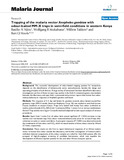| dc.description.abstract | Abstract
Background
The successful development of odour-baited trapping systems for mosquitoes depends on the identification of behaviourally active semiochemicals, besides the design and operating principles of such devices. A large variety of 'attractants' has been identified in laboratory investigations, yet few of these increase trap catches in the field. A contained system, intermediate between the laboratory and open field, is presented and previous reports that human foot odour induces behavioural responses of Anopheles gambiae confirmed.
Methods
The response of 3–5 day old female An. gambiae towards odour-baited counterflow geometry traps (MM-X model; American Biophysics Corp., RI) was studied in semi-field (screen house) conditions in western Kenya. Traps were baited with human foot odour (collected on socks), carbon dioxide (CO2, 500 ml min-1), ammonia (NH3), 1-octen-3-ol, or various combinations thereof. Trap catches were log (x+1) transformed and subjected to Latin square analysis of variance procedures.
Results
Apart from 1-octen-3-ol, all odour baits caused significant (P < 0.05) increases in trap catches over non-baited traps. Foot odour remained behaviourally active for at least 8 days after collection on nylon or cotton sock fabric. A synergistic response (P < 0.001) was observed towards the combination of foot odour and CO2, which increased catches of these odours alone by 3.8 and 2.7 times, respectively.
Conclusion
These results are the first to report behavioural responses of an African malaria vector to human foot odour outside the laboratory, and further investigation of fractions and/or individual chemical components of this odour complex are called for. Semi-field systems offer the prospect of high-throughput screening of candidate kairomones, which may expedite the development of efficient trap-bait systems for this and other African mosquito species. | |


